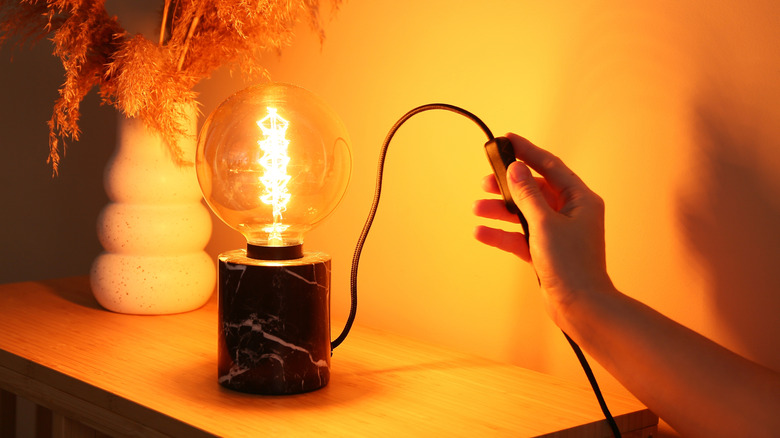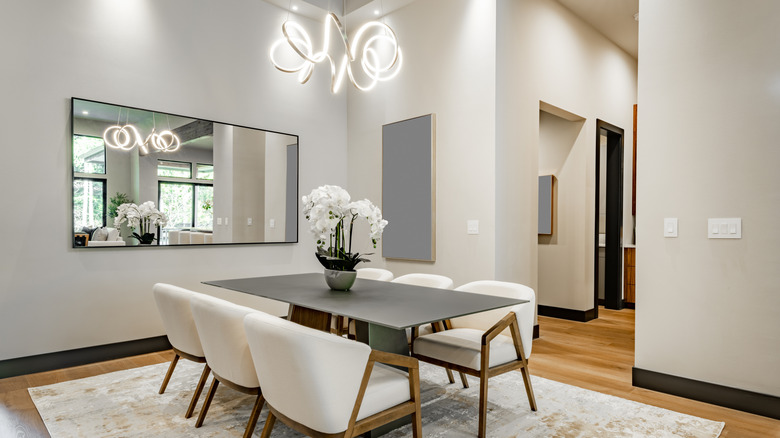How To Tell If The Lighting In Your Home Is Unbalanced
We may receive a commission on purchases made from links.
Walking into a well-lit room is like getting a hug from a close friend — warm, welcoming, and just right. Your home may get a ton of natural light during the daytime, but what really matters is how it lights up after dark. Unbalanced lighting in your home happens when some areas are too brightly lit while other areas are gloomy, dark, and uncomfortable to be in.
You'll know the lighting is too dim if you find your eyes straining or you set aside the tasks you'd normally tackle happily in the evenings. Lighting that is too dim can make you feel sleepy earlier than your normal bedtime. It can also shut down conversations, as much of the non-verbal communication is lost because you simply can't see each other. The line between cozy and too dark can be determined by how you feel in the room.
Being under lighting that's too bright is unsettling and causes as much eye strain as lighting that's too dim. Some folks may find themselves getting headaches or migraines more frequently. Overly bright lights can be fixed by choosing the right light bulbs. The whole feel of your room can change when you consider soft white versus warm white lights and how to choose the best one for your home. Unbalanced lighting can negatively affect your productivity, and an uneven lighting plan has a greater impact on our well-being than many people realize.
Simple steps to achieving a balanced spread of light
The easiest way to tell if the lighting in your home is inconsistent is to tackle each room one at a time. Turn all the lights on, stand in the doorway, and have a critical look. If there are light pools bright enough to put someone in the spotlight or inky patches of shadow, you may need to rethink your lighting design. Only once you've identified the too-bright and the too-dark spots — and recognized how the brightness of your lamps affect your mood – can you figure out how to go about restoring the balance.
Fix the dark spots by assessing how much space you have. Would a floor lamp work? Consider getting a torchiere lamp that shines upward and washes the ceiling in a gentle glow. Is there a handy place for a desk lamp? Or would it be better to suspend a pendant? An ideal setup provides focused, brighter lighting over work areas, highlights features, and covers the rest of the room in a soft wash of ambient lighting.
For lighting that's too bright, install dimmer switches, such as the Amico Dimmer Light Switch. Dimmer switches allow you to adjust the lighting to suit your needs, whether you're working on a jigsaw puzzle on the coffee table and need brighter light, or you're having a family movie night and need softer illumination. Most light switches can be swapped out for dimmer lights, though check with your lighting provider.
Other factors that affect unbalanced lighting in the home
As weird as it sounds, your light fittings aren't the only things that affect how well-lit your rooms are. The colors you choose to paint your ceilings and walls, as well as the colors of your furniture, all work together to affect the brightness of each room. Rooms painted in light colors tend to bounce light around and make everything brighter. Dark walls can swallow up the light and make rooms feel smaller and cozier. That room that's so bright it hurts your eyes? A simple coat of dark paint may sort it out.
To brighten a dark room, consider including reflective surfaces in the space. Hanging a mirror to reflect the light from the fittings at night and the natural light during the day is very effective. You can double the brightness in a space with this one simple step. Repositioning a mirror that you already have may be all you need to do. Reflective surfaces, such as glass-topped or metal coffee and end tables, also bounce light and create an airy feeling.
It's not just furniture that can add to the luminance of an area. You can brighten a dark room with a windowsill trick, add multiple light sources, or use a light-colored throw to brighten up a dark couch. By tackling the issue from multiple angles, you'll create the right level of comfortable and functional lighting for each space.


